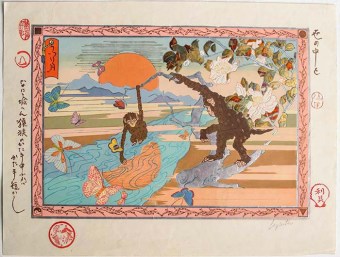Ask a question
Giovanni Berio / LIGUSTRO (1924-2015)
(E-goyomi I monaci e la luna sole pomeriggio varainte 1)
60-color polychrome woodcut, Year of the Horse 1990, E-Goyomi (Calendar print)
Issues: 6 with different colors and papers
Techniques used in use in the EDO period in Japan:
Nishiki-E: Brocade prints, a term used to denote the coloured woodcuts produced from 1765 onward using cherry and pear woods
Bokashi: Shaded colour printing
Gin-Sunago: Silver flakes and powder scattered in the surface to create effects of light in individual plates in order to create identical prints
Kimekomi: Printing using the reverse of the Karazuri technique giving an engraved, grooved effect
Kindei: Colour given by powdered gold to cover small areas of the prints with decorative motifs
Kinpaku: Use of gold leaf to cover larger areas of the print
Kirazuri: Mica prints, with the application of particles of powdered pearl and mica in order to create silvered or shining effects
Sabi-Bori: Method of engraving used to create the effect of brush strokes in Japanese calligraphy
Kira-E: Mica prints
Koroku: Printing technique used to enhance profiles
Wood: The engravings for the contours and for the clichés were made on cherry wood (Sakura)
Paper: Japanese Fine Papers
Size of the print: 49,5 cm x 37,5 cm
Poetry, always printed with Nishiki-e technique:
What should our life be compared to?
It is like a monk trying to stretch out his arms
(towards the moon reflected in the water)
but if one arm is extended, the other will be contracted.
(So it is the law of relativity that dominates our earthly life. One cannot have everything that our yearning soul desires to achieve)
Zen Master Sengai
Chinese cinnabar seals
Signature: Bottom right seal RI-GU LIGUSTRO; top left Ligustro MANY COLORS, bottom left seal YEAR OF THE HORSE, top left Mon MONACO IN MEDITATION, top right POET seal
